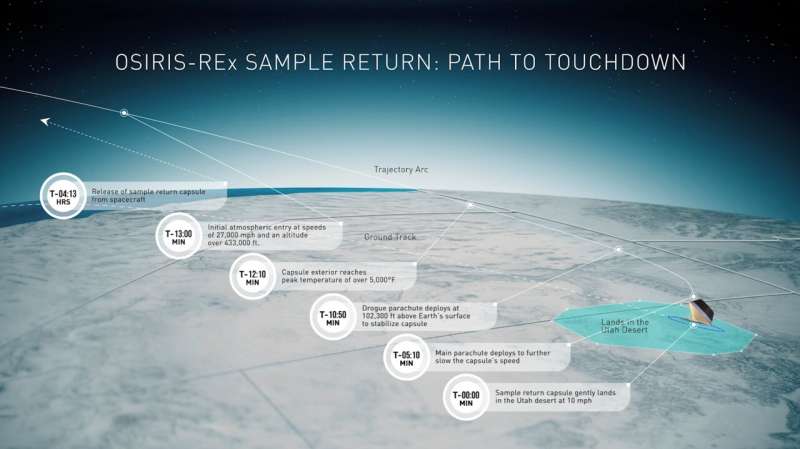This article has been reviewed according to Science X's editorial process and policies. Editors have highlighted the following attributes while ensuring the content's credibility:
fact-checked
trusted source
proofread
Here's how the Sept. 24 asteroid sample delivery will work

Early morning on Sunday, Sept. 24, the OSIRIS-REx spacecraft's sample capsule will come face-to-face with Earth's atmosphere for the first time since the mission's 2016 launch. On board are an estimated 8.8 ounces, or 250 grams, of rocky material collected from the surface of Bennu in 2020—NASA's first asteroid sample and the largest ever collected in space.
When it approaches Earth, the OSIRIS-REx spacecraft won't slow down as it makes its sample drop-off. Instead, when it reaches 63,000 miles (or 102,000 kilometers) above Earth's surface—about one-third the distance from Earth to the moon—a message from operators on the ground will trigger the capsule's release and the capsule will be sent spinning toward the atmosphere below. Twenty minutes after the drop-off, the spacecraft will fire its thrusters to divert past Earth toward asteroid Apophis, where it will continue investigating our solar system under a new name: OSIRIS-APEX (OSIRIS-Apophis Explorer).
Meanwhile, after zooming through space for four hours, the capsule will pierce Earth's atmosphere at 8:42 a.m. MDT (10:42 a.m. EDT), traveling about 27,650 mph (44,500 kph). At this pace, the compression of Earth's atmosphere will produce enough energy to envelop the capsule in a superheated ball of fire. A heat shield will help to regulate the temperature inside the capsule, keeping the sample safe at a temperature similar to that of Bennu's surface.
Parachutes will bring the capsule's descent to a safe landing speed. A drogue parachute designed to provide a stable transition to subsonic speeds will deploy first, about 2 minutes after the capsule enters the atmosphere. Six minutes later—at about 1 mile (1.6 kilometers) above the desert—the main chute will unfurl, carrying the capsule the rest of the way to a 36-mile by 8.5-mile (58-kilometer by 14-kilometer) area on the military range. At touchdown, the capsule will have slowed to about 11 mph (18 kph).
Finally, just 13 minutes after entering the atmosphere, the capsule will be on Earth for the first time in seven years, awaiting the recovery team's approach.
About 20 minutes before the capsule lands, when it is still high above the veil of Earth's atmosphere, the recovery field team will board four helicopters and head out into the desert. The infrared glow of the capsule's heat signature will be tracked by thermal instruments until the capsule becomes visible to optical instruments, giving the recovery team a way to trace the capsule's Earthbound path. The goal for the recovery team is to retrieve the capsule from the ground as quickly as possible to avoid contaminating the sample with Earth's environment.
Once located and packaged for travel, the capsule will be flown via helicopter longline to a temporary clean room on the military range, where it will undergo initial processing and disassembly in preparation for its journey by aircraft to NASA's Johnson Space Center in Houston, where the sample will be documented, cared for, and distributed for analysis to scientists worldwide.
Provided by NASA





















